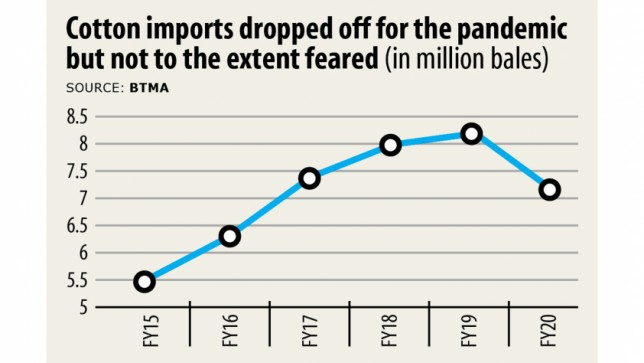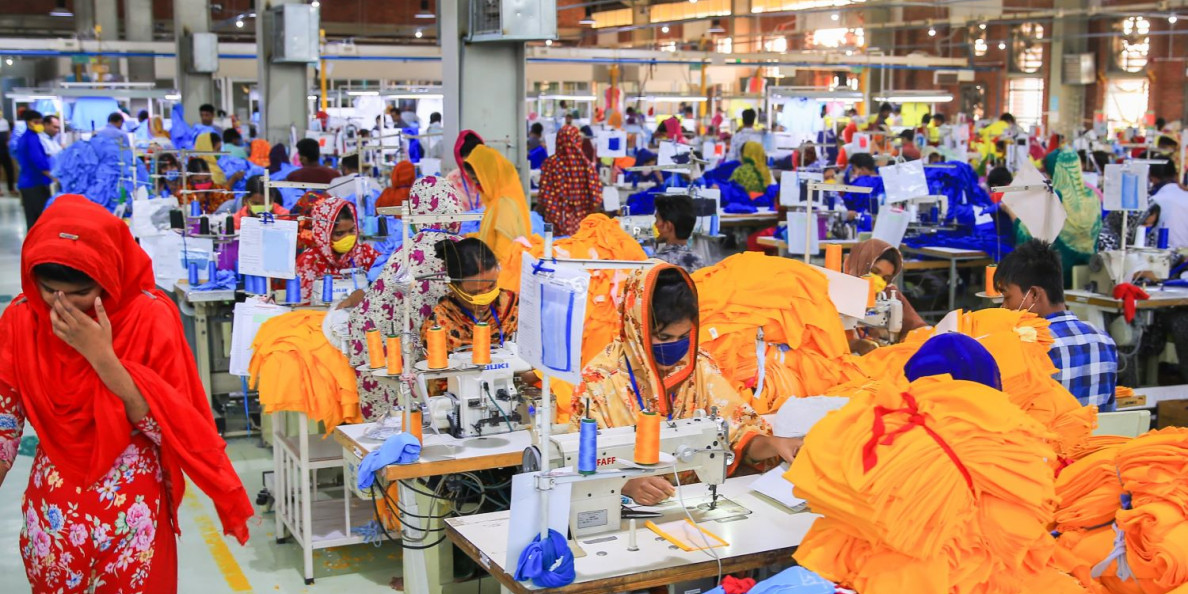Cotton imports witnessed a slump for the first time in over a decade last fiscal year due to a fall in demand from local mills amid a stunning drop in apparel work orders for the global coronavirus pandemic.
In fiscal 2019-20, Bangladesh imported 7.1 million bales of cotton, down 13.4 per cent from a year earlier, according to data from the Bangladesh Textile Mills Association (BTMA).
As in previous years, cotton imports were on the rise up until February due to the high demand for yarn and other fabrics from garment exporters.
However, imports crashed from then onwards as most garment factories were shut down after the government declared a two-month 'general holiday' on 26 March aimed at curbing the spread of coronavirus.

As a result, most spinning and weaving mills were also shuttered during the March-June period.
When the nationwide lockdown eventually came to an end on May 30, most mills resumed operations with previous stocks of cotton rather than importing more despite the significant fall in price for the cellulose fibre at international markets.
Cotton is now trading at between $0.62 to $0.64 per pound in the New York Futures markets, down from the previous range of $0.70 to $0.75 during pre-pandemic times.
Almost all of Bangladesh's domestic demand for cotton is met through imports as local growers can only supply less than 3 per cent of the country's annual demand.
Both the import and consumption of cotton in Bangladesh had risen steadily for the past decade as the country's thriving garment sector has led to the formation of many strong backward linkage industries.
The garment sector has seen tremendous growth over the years as Bangladesh's status as a least-developed country allows its apparel products to enjoy duty-free access to many developing and developed nations.
"Since last month, the consumption of cotton started growing as garment factories resumed production after about three months," said Khorshed Alam, managing director of Little Group, a leading cotton importer and consumer.
Typically, Alam imports nearly 33,000 bales of cotton each year. One bale equals 480 pounds.
Millers used their previous stocks of cotton after reopening their factories following the lockdown.
Besides, many importers delayed releasing cotton shipment from the port amid the coronavirus outbreak.
Textile millers also faced other issues, such as having to preserve unsold stocks of yarn and other fabrics.
However, the previous inventory of such materials has emptied significantly due to the return of demand from garment manufacturers.
"So now, we will start importing cotton again," Alam added.
The pandemic is the sole reason for the declining trend of cotton imports, said Razeeb Haider, managing director of Outpace Spinning Mills.
"I am very much hopeful that cotton imports will rise again soon as the demand for yarn and other fabrics has been increasing gradually," he added.
Most garment factories in Bangladesh are now running at 75 per cent of their total production capacity and this indicates that work orders are coming back.
The demand for various fabric materials could go even higher after September if the international retailers continue to source their products from Bangladesh at the current pace, he added.
Echoing the sentiments of Alam and Haider, BTMA President Mohammad Ali Khokon said that more than 50 per cent of the annual sales target for fabrics had been met by July.
"I hope sales recover by more than 75 per cent by September and fully by the year-end."
By January next year, sales should return to its previous growth rate, Khokon added.
Of the $8 billion invested in the primary textile sector, Tk 20,000 crore has already been lost to the coronavirus fallout, according to numerous millers.
About 11,000 micro, small, medium and large spinning, printing, dyeing and weaving mills were unable to produce any goods in March and April for fear of coronavirus contagion.
As a result, the millers missed two mega sales events, Pahela Baishakh and Eid-ul-Fitr.
Currently, there are about 450 spinning mills in the country while total investment in the sector stands at Tk 40,000 crore. Besides, Tk 30,000 crore has been invested in the weaving and dyeing sectors.


